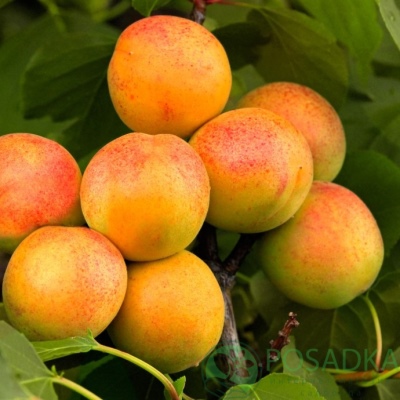
- Authors: L.A. Kramarenko (Main Botanical Garden named after N.V. Tsitsin RAS)
- Year of approval: 2004
- Escapes: straight, brownish-yellowish, glabrous, moderately branched
- Flowers: medium, white
- Fruit weight, g: 30-50
- Fruit shape: oval, slightly uneven, laterally compressed
- Skin : pubescent, coarse
- Fruit color: lemon yellow with a bright pink blush
- Pulp color : orange
- Pulp (consistency): juicy, medium density, slightly mealy
Monastyrskiy apricot is a popular universal variety. It is acclimatized for the Moscow region, but it shows its best properties in a warmer climate. Trees are distinguished by regular fruiting; you do not have to wait long for the first harvest from them either.
Breeding history
The Monastyrsky apricot was raised by the staff of the Main Botanical Garden of the Russian Academy of Sciences named after N.V. Tsitsin. It was approved for cultivation after variety trials in 2004. When crossing, the parental varieties of apricots Bereznyakovsky and Shabolovsky were used. Seedlings obtained by free pollination in 3-4 generations.
Description of the variety
The trees are vigorous, with a spreading spherical crown, not too thickened, with straight, moderately branched shoots. Leaves are elongated, pointed, oval, wide. The plate is shiny and smooth, colored dark green. Flowers and fruits appear on all types of shoots.
Trees grow up to 5 m. The root system is well developed and powerful. The flowers are white, up to 3 cm in diameter, abundantly formed.
Fruit characteristics
Apricots from these trees are harvested large, with an average weight of 30-50 g. Fruits are oval, slightly flattened from the sides. The skin is rough, pubescent, colored lemon yellow with a bright pink blush on the surface. The pulp is orange inside, with a large, poorly separated bone. The fruits are well stored for a long time, suitable for transportation.
Taste qualities
The pulp is juicy, slightly mealy, of medium density. The taste is sweet and sour, with an average rating of about 3.5 points. The fruit has a rather strong, pleasant aroma.
Ripening and fruiting
Late variety, bears fruit from mid to late August. The yield is uneven. Monastic - a fast-growing apricot that begins to bear fruit 3-4 years after vaccination. The productivity period is 20-25 years.

Yield
Monastyrskiy is a high-yielding apricot, yielding an average of 150 centners per hectare when harvested. From a tree, the yield is about 25 kg.
Growing regions
Monastyrsky apricot is intended for cultivation in the Central region of the Russian Federation.
Growing and care
The main agrotechnical measures for the care of apricot trees of the Monastyrsky variety are quite simple. They need periodic watering without waterlogging - by drip irrigation, as well as in furrows or holes. Under the root, 3 buckets of water are fed for each plant. During the season, the event is repeated 3-4 times. Water-charging irrigation is also useful in the spring - at the beginning of the growing season, and in the fall, before wintering.
It is imperative to feed Monastyrsky before flowering in order to avoid shedding the fruits. Pounded eggshells, wood ash, granulated superphosphate are added to the trunk circle. In early spring, every year, starting from 2 years after planting, organic matter is introduced - a solution of bird droppings.
Lush crown requires mandatory formation in the early years.It is recommended to prune a young tree for the first time immediately after planting, leaving only 80-90 cm of growth above the soil surface. It is important to remember that the central trunk is always formed longer than the skeletal branches.



Disease and pest resistance
The general assessment of Monastyrsky's resistance to fungal infections and infections is average. To this extent, it is affected by clasterosporiosis, which is especially dangerous for apricot trees. The variety is well protected from aphid infestation. Resistant to monilial burn. Among other pests, the danger is represented by caterpillars of leaf rollers, hawthorns and moths.

Winter hardiness and the need for shelter
The variety has good winter hardiness. Withstands frosts down to -30 degrees.
Location and soil requirements
When choosing a site for planting, it is important to highlight well-lit places located on a hill. In the early years of growing, plants need to be protected from strong cold winds. The composition of the soil is preferable moderately loose, loamy or sandy loam, with neutral acidity.
Review overview
According to amateur gardeners, Monastyrsky apricot is one of the most easily adaptable varieties to changes in external conditions. Even in years with recurrent frosts on these trees, the harvest is preserved, although not very plentiful. Plants easily tolerate severe frosts, drought, and other external influences. The taste of the fruit is assessed by summer residents as pleasant, rich, highly praised and a characteristic aroma.
Gardeners note that Monastyrsky is quite suitable for growing for sale. The fruit has a good presentation. In compote and canning, they also retain an attractive appearance.
Summer residents most often express dissatisfaction with this variety of apricots in relation to the weak calibration of the fruits. Their sizes vary from very large to medium, the harvest is also unevenly maturing, especially in cold summers. It is noted that the rates of fruit set directly depend on climatic conditions. In the conditions of Ukraine and the south of Russia, the variety requires regular preventive treatments for diseases.































































